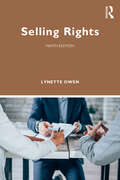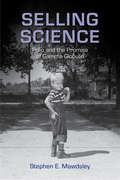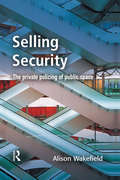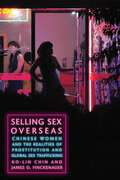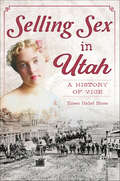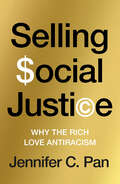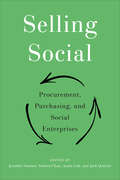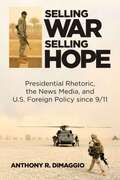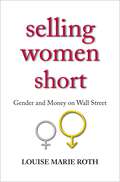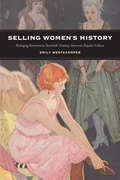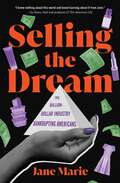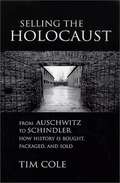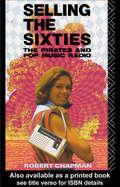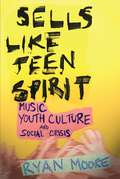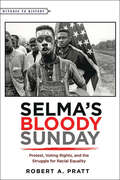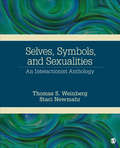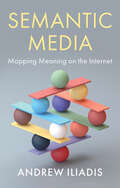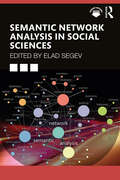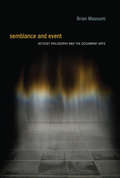- Table View
- List View
Selling Rights
by Lynette OwenNow in its ninth edition, Selling Rights has firmly established itself as the leading guide to all aspects of rights sales and co-publications throughout the world.Covering the full range of potential rights, from English-language territorial rights through to serial rights, permissions, rights for the reading-impaired, translation rights, dramatization and documentary rights, electronic and multimedia rights, this book constitutes a comprehensive introduction and companion to the topic. Besides individual types of rights, topics covered also include book fairs, Open Access, the ongoing impact of new electronic hardware, and the rights implications of acquisitions, mergers, and disposals.This fully updated edition includes:• New IP legislation and proposed legislation in the UK and the USA, including changes regarding TDM and the post-Brexit implications of EU directives and exhaustion of rights.• The implications of artificial intelligence (AI) for author contracts and licensing contracts.• The impact of the pandemic and its aftermath on the promotion and sale of rights.• Coverage of censorship in countries around the world, especially in relation to LGBTQI+ content, as well as political situations which have impacted on rights trading.• The impact of streaming services on opportunities for licensing television and film rights.• Major revisions to the chapters on audio and video recording rights, the internet and publishing, and electronic publishing and digital licensing.Selling Rights is an essential reference tool and an accessible and illuminating guide to current and future issues for rights professionals and students of publishing.
Selling Science: Polio and the Promise of Gamma Globulin
by Stephen E. MawdsleyToday, when many parents seem reluctant to have their children vaccinated, even with long proven medications, the Salk vaccine trial, which enrolled millions of healthy children to test an unproven medical intervention, seems nothing short of astonishing. In Selling Science, medical historian Stephen E. Mawdsley recounts the untold story of the first large clinical trial to control polio using healthy children--55,000 healthy children--revealing how this long-forgotten incident cleared the path for Salk's later trial. Mawdsley describes how, in the early 1950s, Dr. William Hammon and the National Foundation for Infantile Paralysis launched a pioneering medical experiment on a previously untried scale. Conducted on over 55,000 healthy children in Texas, Utah, Iowa, and Nebraska, this landmark study assessed the safety and effectiveness of a blood component, gamma globulin, to prevent paralytic polio. The value of the proposed experiment was questioned by many prominent health professionals as it harbored potential health risks, but as Mawdsley points out, compromise and coercion moved it forward. And though the trial returned dubious results, it was presented to the public as a triumph and used to justify a federally sanctioned mass immunization study on thousands of families between 1953 and 1954. Indeed, the concept, conduct, and outcome of the GG study were sold to health professionals, medical researchers, and the public at each stage. At a time when most Americans trusted scientists, their mutual encounter under the auspices of conquering disease was shaped by politics, marketing, and at times, deception. Drawing on oral history interviews, medical journals, newspapers, meeting minutes, and private institutional records, Selling Science sheds light on the ethics of scientific conduct, and on the power of marketing to shape public opinion about medical experimentation.
Selling Security
by Alison WakefieldIn recent years there has been massively increased demand for the services of the private security industry, which has now assumed a far greater role in policing areas that were once the sphere of the police --for example, shopping malls, leisure parks and transportation terminals. This book provides a detailed account of the developments in urban planning, public policy and the commercial world which have promoted the development of private security, and provides a unique examination of security teams in operation in three very different environments --a shopping mall, a retail and leisure complex, and an arts centre. The study is set within a broader context that considers changes in retail and leisure patterns that have promoted the development of large, multi-purpose developments, shifts in town centre planning to create more secure high street retail and leisure facilities, and the promotion of CCTV and security patrols. Finally, the book considers the ethical issues that arise with the massively increased use of private security, and the broader policy issues which arise.
Selling Sex Overseas: Chinese Women and the Realities of Prostitution and Global Sex Trafficking
by Ko-lin Chin James O. Finckenauer2013 Outstanding Book Award Winner from the Division of International Criminology, American Society of CriminologyEvery year, thousands of Chinese women travel to Asia and the United States in order to engage in commercial sex work. In Selling Sex Overseas, Ko-lin Chin and James Finckenauer challenge the current sex trafficking paradigm that considers all sex workers as victims, or sexual slaves, and as unwilling participants in the world of commercial sex. Bringing to life an on-the-ground portrait of this usually hidden world, Chin and Finckenauer provide a detailed look at all of its participants: sex workers, pimps, agents, mommies, escort agency owners, brothel owners, and drivers. Ultimately, they probe the social, economic, and political organization of prostitution and sex trafficking, contradicting many of the ‘moral crusaders’ of the human trafficking world.
Selling Sex in Utah: A History of Vice (The History Press)
by Eileen Hallet StoneUncovering Sin, Scandal and Sensuality In the late 1840s, the new frontier west of the Missouri River opened its floodgates to opportunity and adventure. In a new land, where men were lonely and women scarce, prostitutes poured in to ply their trade wherever they could--under trees, in wagons or random shanties. Within decades, prostitution expanded into cities and towns. Red light districts, brothels and cribs sprouted like wildflowers. Ogden's notorious madam Belle London enticed Salt Lake Councilmen to hire her to oversee their one hundred fifty room crib stockade. Park City's Mother Urban successfully defended her sixteen row houses as "necessities" for thousands of miners. The ballyhooed brothels of Helper stimulated "hunting trips" for Salt Lake men willing to travel for sex. Award-winning author Eileen Hallet Stone combed newspapers, archives and court cases to examine the lives, equity and infamy of Utah prostitution.
Selling Sexy: Victoria’s Secret and the Unraveling of an American Icon
by Lauren Sherman Chantal FernandezThe story of how Victoria’s Secret skyrocketed from a tiny chain of boutiques to a retail phenomenon with more than $8 billion in annual sales at its peak—all while defining an impossible beauty standard for generations of American women—before the brand’s tight grip on the industry finally slippedVictoria’s Secret is one of the most influential and polarizing brands to ever infiltrate the psyche of the American consumer. Almost right at its start in the late 1970s, the company developed a cult following for its glamorous catalogs. Back then, shoppers had few alternatives to the stodgy department stores that sold most of the nation’s intimate apparel. By 1982, the founders of Victoria’s Secret avoided bankruptcy by selling to Les Wexner, the fast-fashion pioneer behind the Limited, whose empire of mall brands would go on to dominate American retail for forty years.Wexner turned Victoria’s Secret into a multibillion-dollar business, and the brand’s cultural influence soared thanks to its airbrushed advertisements and annual televised fashion show, which drew millions of viewers each year. Its supermodel spokeswomen, the sweet but sultry Angels, personified a new American beauty standard.But as our definition of beauty expanded, Victoria’s Secret failed to evolve and reached a crisis point. Meanwhile, Wexner became increasingly known for his complicated relationship with sex trafficker Jeffrey Epstein, his former financial adviser and confidant.Selling Sexy expertly draws from sources within Victoria’s Secret and across the industry to examine the unprecedented rise of one of the most innovative brands in retail history—a brand that today, under new ownership, is desperately trying to seduce shoppers again.
Selling Social Justice: Why the Ruling Class Loves Antiracism
by Jennifer C. PanAmericans have been sold a version of social justice that fails to deliverThe national racial reckoning that began in 2020 promised to radically restructure American society from the bottom up. But five years on, it has mainly served to strengthen the ruling class and deliver the rich an opportunity to rehabilitate a profoundly unequal economic order precisely at a moment when the stability of the system and the public&’s trust in it are drastically deteriorating.Corporations have used antiracism to consolidate their political power and evade government regulation. Employers have surveilled and undermined workers through counterproductive diversity, equity, and inclusion trainings. Affluent professionals and Democratic politicians have exacerbated a stark class divide by pushing half-baked &“racial equity&” policies that come at the expense of the majority of working people. And the right has reacted to these developments by stoking a toxic culture war against &“wokeness&” that serves only as a distraction from the increasing economic hardship faced by Americans of all races.Selling Social Justice investigates the rise and spread of contemporary antiracist ideology and shows how the rich came to embrace this particular form of justice. In this provocative and thoroughly researched account, Jennifer C. Pan explores why, in a twenty-first-century economy of increasing scarcity, antiracism is the wrong frame for understanding and fighting inequality.
Selling Social: Procurement, Purchasing, and Social Enterprises
by Jack Quarter Andrea Chan Jennifer Sumner Annie LukSince the 2010s, all levels of governments in Canada have gradually initiated social procurement as a policy tool to further their social values and political agendas. Social enterprises of various shapes and sizes across the country have served as partners in the execution of those agendas. Selling Social examines the experiences of these enterprises in social procurement and social purchasing. Selling Social presents the findings of a three-year Canadian research project detailing experiences of work integration social enterprises (WISEs) selling their goods and services to organizational purchasers, including governments, businesses, and non-profit organizations. Drawing on survey findings and interviews, the book explores a diverse group of social enterprises from across Canada, showcasing their successes and their challenges based on real-life examples to aid social enterprises that are considering this path. The book emphasizes the importance of including social and environmental considerations in procurement and purchasing decisions, particularly at larger scales and through public policy. In doing so, Selling Social extends the understanding of social enterprises beyond their social and economic outcomes and into the broader movement towards responsible procurement and purchasing.
Selling War, Selling Hope: Presidential Rhetoric, The News Media, And U. S. Foreign Policy Since 9/11
by Anthony R. DiMaggioDetails how presidents utilize mass media to justify foreign policy objectives in the aftermath of 9/11.
Selling Women Short: Gender and Money on Wall Street
by Louise Marie RothRocked by a flurry of high-profile sex discrimination lawsuits in the 1990s, Wall Street was supposed to have cleaned up its act. It hasn't. Selling Women Short is a powerful new indictment of how America's financial capital has swept enduring discriminatory practices under the rug. Wall Street is supposed to be a citadel of pure economics, paying for performance and evaluating performance objectively. People with similar qualifications and performance should receive similar pay, regardless of gender. They don't. Comparing the experiences of men and women who began their careers on Wall Street in the late 1990s, Louise Roth finds not only that women earn an average of 29 percent less but also that they are shunted into less lucrative career paths, are not promoted, and are denied the best clients. Selling Women Short reveals the subtle structural discrimination that occurs when the unconscious biases of managers, coworkers, and clients influence performance evaluations, work distribution, and pay. In their own words, Wall Street workers describe how factors such as the preference to associate with those of the same gender contribute to systematic inequality. Revealing how the very systems that Wall Street established ostensibly to combat discrimination promote inequality, Selling Women Short closes with Roth's frank advice on how to tackle the problem, from introducing more tangible performance criteria to curbing gender-stereotypical client entertaining activities. Above all, firms could stop pretending that market forces lead to fair and unbiased outcomes. They don't.
Selling Women Short: The Landmark Battle for Workers' Rights At Wal-Mart
by Liza FeatherstoneOn television, Wal-Mart employees are smiling women delighted with their jobs. But reality is another story. In 2000, Betty Dukes, a fifty-two-year-old black woman in Pittsburg, California, became the lead plaintiff inDukes v. Wal-Mart Stores, a class action, representing 1. 6 million women. In her explosive investigation of this historic lawsuit, journalist Liza Featherstone reveals how Wal-Mart, a self-styled "family-oriented," Christian company: Deprives women (but not men) of the training they need to advance. Relegates women to lower-paying jobs like selling baby clothes, reserving the more lucrative positions for men. Inflicts punitive demotions on employees who object to discrimination. Exploits Asian women in its sweatshops in Saipan, a U. S. commonwealth. Featherstone goes on to reveal the creative solutions that Wal-Mart workers around the country have found, like fighting for unions, living-wage ordinances, and childcare options. Selling Women Shortcombines the personal stories of these employees with superb investigative journalism to show why women who work these low-wage jobs are getting a raw deal, and what they are doing about it. A new preface to the paperback edition will reflect on Wal-Mart's response to this lawsuit and its critics-including this one.
Selling Women's History: Packaging Feminism in Twentieth-Century American Popular Culture
by Emily WestkaemperOnly in recent decades has the American academic profession taken women's history seriously. But the very concept of women's history has a much longer past, one that's intimately entwined with the development of American advertising and consumer culture. Selling Women's History reveals how, from the 1900s to the 1970s, popular culture helped teach Americans about the accomplishments of their foremothers, promoting an awareness of women's wide-ranging capabilities. On one hand, Emily Westkaemper examines how this was a marketing ploy, as Madison Avenue co-opted women's history to sell everything from Betsy Ross Red lipstick to Virginia Slims cigarettes. But she also shows how pioneering adwomen and female historians used consumer culture to publicize histories that were ignored elsewhere. Their feminist work challenged sexist assumptions about women's subordinate roles. Assessing a dazzling array of media, including soap operas, advertisements, films, magazines, calendars, and greeting cards, Selling Women's History offers a new perspective on how early- and mid-twentieth-century women saw themselves. Rather than presuming a drought of female agency between the first and second waves of American feminism, it reveals the subtle messages about women's empowerment that flooded the marketplace.
Selling the American People: Advertising, Optimization, and the Origins of Adtech
by Lee McGuiganHow marketers learned to dream of optimization and speak in the idiom of management science well before the widespread use of the Internet.Algorithms, data extraction, digital marketers monetizing "eyeballs": these all seem like such recent features of our lives. And yet, Lee McGuigan tells us in this eye-opening book, digital advertising was well underway before the widespread use of the Internet. Explaining how marketers have brandished the tools of automation and management science to exploit new profit opportunities, Selling the American People traces data-driven surveillance all the way back to the 1950s, when the computerization of the advertising business began to blend science, technology, and calculative cultures in an ideology of optimization. With that ideology came adtech, a major infrastructure of digital capitalism.To help make sense of today's attention merchants and choice architects, McGuigan explores a few key questions: How did technical experts working at the intersection of data processing and management sciences come to command the center of gravity in the advertising and media industries? How did their ambition to remake marketing through mathematical optimization shape and reflect developments in digital technology? In short, where did adtech come from, and how did data-driven marketing come to mediate the daily encounters of people, products, and public spheres? His answers show how the advertising industry's efforts to bend information technologies toward its dream of efficiency and rational management helped to make "surveillance capitalism" one of the defining experiences of public life.
Selling the Dream: The Billion-Dollar Industry Bankrupting Americans
by Jane MarieA Next Big Idea Club Must-Read for March 2024 * A Bustle Best New Book of Spring 2024 Peabody and Emmy Award–winning journalist Jane Marie expands on her popular podcast The Dream to expose the scourge of multilevel marketing schemes and how they have profited off the evisceration of the American working class.We&’ve all heard of Amway, Mary Kay, Tupperware, and LuLaRoe, but few know the nefarious way they and countless other multilevel marketing (MLM) companies prey on desperate Americans struggling to make ends meet. When factories close, stalwart industries shutter, and blue-collar opportunities evaporate, MLMs are there, ready to pounce on the crumbling American Dream. MLMs thrive in rural areas and on military bases, targeting women with promises of being their own boss and millions of dollars in easy income—even at the risk of their entire life savings. But the vast majority—99.7%—of those who join an MLM make no money or lose money, and wind up stuck with inventory they can&’t sell to recoup their losses. Featuring in-depth reporting and intimate research, Selling the Dream reveals how these companies—often owned by political and corporate elites, such as the Devos and the Van Andels families—have made a windfall in profit off of the desperation of the American working class.
Selling the Holocaust: From Auschwitz to Schindler, How History is Bought, Packaged and Sold
by Tim ColeWhat does the Holocaust mean at the end of the twentieth century? Tim Cole examines three of the Holocaust's most emblematic figures--Anne Frank, Adolf Eichmann and Oskar Schindler--and three of the Holocaust's most visited sites-- Auschwitz, Yad Vashem and the United States Holocaust Memorial Museum--to show us how the Holocaust has been mythologized in the popular imagination. What he finds is disturbing. Cole show us an "Auschwitz-land" where tourists have become the "ultimate ruberneckers" passing by and gazing at someone else's tragedy. He shows us a US Holocaust Museum that provides visitors with a "virtual Holocaust" experience. He shows us that, from movies to museums, the "feel good" Holocaust is being made in America. And, above all, he shows us that as the century closes the frightening reality of the Holocaust is being forgotten.
Selling the Sixties: The Pirates and Pop Music Radio
by Robert ChapmanWas it a non-stop psychedelic party or was there more to pirate radio in the sixties than hedonism and hip radicalism? From Kenny Everett's sacking to John Peel's legendary `Perfumed Garden' show, to the influence of the multi-national ad agencies, and the eventual assimilationof aspects of unofficial pop radio into Radio One, Selling the Sixties examines the boom of private broadcasting in Britain. Using two contrasting models of pop piracy, Radios Caroline and London, Robert Chapman sets pirate radio in its social and cultural context. In doing so he challenges the myths surrounding its maverick `Kings Road' image, separating populist consumerism from the economic and political machinations which were the flipside of the pirate phenomenon. Selling the Sixties includes previously unseen evidence from the pirates' archives, revealing interviews and an unrivalled selection of rare audio materials.
Sells like Teen Spirit: Music, Youth Culture, and Social Crisis
by Ryan MooreThis account of modern rock music &“skillfully articulates the brutal social truths that compel young people to create meaning and subculture out of chaos&” (Donna Gaines, author of Teenage Wasteland). In Sells Like Teen Spirit, Ryan Moore tells the story of how music and youth culture have changed along with the economic, political, and cultural transformations of American society over four decades. By attending concerts, hanging out in dance clubs and after-hour bars, and examining the do-it-yourself music scene, Moore gives a riveting, first-hand account of the sights, sounds, and smells of &“teen spirit.&” Moore traces the histories of punk, hardcore, heavy metal, glam, thrash, alternative rock, grunge, and riot grrrl music, and relates them to wider social changes that have taken place. Alongside the thirty images of concert photos, zines, flyers, and album covers in the book, Moore offers original interpretations of the music of a wide range of bands including Black Sabbath, Black Flag, Metallica, Nirvana, and Sleater-Kinney. Written in a lively, witty style, Sells Like Teen Spiritsuggests a more hopeful attitude about the ways that music can be used as a counter to an overly commercialized culture, showcasing recent musical innovations by youth that emphasize democratic participation and creative self-expression—even at the cost of potential copyright infringement. &“Brilliantly situates the histories of several musical styles within the political, economic, and social changes that led to the development of an assortment of rock subgenres . . . engaging.&” —Journal of Youth and Adolescence
Selma's Bloody Sunday: Protest, Voting Rights, and the Struggle for Racial Equality (Witness to History)
by Robert A. Pratt“A fresh look at this historical crossroads which marked the culmination of the Civil Rights Movement . . . timely and engaging.” —Patricia Sullivan, author of Justice RisingOn Sunday afternoon, March 7, 1965, roughly six hundred peaceful demonstrators set out from Brown Chapel A.M.E. Church in a double-file column to march from Selma, Alabama, to the state capital of Montgomery. Leading the march were Hosea Williams of the Southern Christian Leadership Conference and John Lewis of the Student Nonviolent Coordinating Committee. Upon reaching Broad Street, the marchers turned left to cross the Edmund Pettus Bridge that spanned the Alabama River. The violence and horror that was about to unfold at the foot of the bridge would forever mark the day as “Bloody Sunday,” one of the pivotal moments of the civil rights movement. Alabama state troopers fell on the unarmed protestors as they crossed the bridge, beating and tear gassing them. In Selma’s Bloody Sunday, Robert A. Pratt offers a vivid account of that infamous day and the indelible triumph of black and white protest over white resistance. He explores how the march itself—and the 1965 Voting Rights Act that followed—represented a reaffirmation of the nation’s centuries-old declaration of universal equality and the fulfillment of the Fifteenth Amendment to the Constitution.Selma’s Bloody Sunday offers a fresh interpretation of the ongoing struggle by African Americans to participate freely in America’s electoral democracy. Jumping forward to the present day, Pratt uses the march as a lens through which to examine disturbing recent debates concerning who should, and who should not, be allowed to vote.
Selma’s Bloody Sunday: Protest, Voting Rights, and the Struggle for Racial Equality (Witness to History)
by Robert A. PrattThe march from Selma to Montgomery starkly illustrated the claims of the civil rights movement—and the raw brutality of the forces arrayed against it.On Sunday afternoon, March 7, 1965, roughly six hundred peaceful demonstrators set out from Brown Chapel A.M.E. Church in a double-file column to march from Selma, Alabama, to the state capital of Montgomery. Leading the march were Hosea Williams of the Southern Christian Leadership Conference and John Lewis of the Student Nonviolent Coordinating Committee. Upon reaching Broad Street, the marchers turned left to cross the Edmund Pettus Bridge that spanned the Alabama River. "When we reached the crest of the bridge," recalls John Lewis, "I stopped dead still. So did Hosea. There, facing us at the bottom of the other side, stood a sea of blue-helmeted, blue-uniformed Alabama state troopers, line after line of them, dozens of battle-ready lawmen stretched from one side of U.S. Highway 80 to the other. Behind them were several dozen more armed men—Sheriff Clark’s posse—some on horseback, all wearing khaki clothing, many carrying clubs the size of baseball bats."The violence and horror that was about to unfold at the foot of the bridge would forever mark the day as "Bloody Sunday," one of the pivotal moments of the civil rights movement. Alabama state troopers fell on the unarmed protestors as they crossed the bridge, beating and tear gassing them. In Selma’s Bloody Sunday, Robert A. Pratt offers a vivid account of that infamous day and the indelible triumph of black and white protest over white resistance. He explores how the march itself—and the 1965 Voting Rights Act that followed—represented a reaffirmation of the nation’s centuries-old declaration of universal equality and the fulfillment of the Fifteenth Amendment to the Constitution.Selma’s Bloody Sunday offers a fresh interpretation of the ongoing struggle by African Americans to participate freely in America’s electoral democracy. Jumping forward to the present day, Pratt uses the march as a lens through which to examine disturbing recent debates concerning who should, and who should not, be allowed to vote. Drawing on archival materials, secondary sources, and eyewitness accounts of the brave men and women who marched, this gripping account offers a brief and nuanced narrative of this critical phase of the black freedom struggle.
Selves, Symbols, and Sexualities: An Interactionist Anthology
by Thomas S. Weinberg Staci D. NewmahrOffering an anthology of original articles on sexuality from a sociological perspective, Selves, Symbols, and Sexualities: An Interactionist Anthology focuses on the diverse and multi-layered meanings of sexuality, sexual behaviors and sexual identities. Thomas S. Weinberg and Staci Newmahr bring you essays that explore sexuality as a social process. As a whole, the book takes the perspective that what each of us understands to be sexual is constructed through everyday social processes and interaction, situated in particular spaces and moments, identified through our social-sexual presentations, and symbolized through language, objects and practices. The book is organized around these four distinct but interrelated processes, and augmented by personal narratives around relevant issues. The authors’ goals for the book are to engage students in the sociological enterprise by providing interesting and insightful entries that emphasize the importance of meaning-making in human sexuality, and to provide them with conceptual tools to understand human sexuality in a complex and quickly changing sexual landscape.
Semantic Media: Mapping Meaning on the Internet
by Andrew IliadisMedia technologies now provide facts, answers, and &“knowledge&” to people – search engines, apps, and virtual assistants increasingly articulate responses rather than direct people to other sources. Semantic Media is about this emerging era of meaning-making technologies. Companies like Apple, Google, Facebook, Amazon, and Microsoft organize information in new media products that seek to &“intuitively&” grasp what people want to know and the actions they want to take. This book describes some of the insidious technological practices through which organizations achieve this while addressing the changing contexts of internet searches, and examines the social and political consequences of what happens when large companies become primary sources of information. Written in an accessible style, Semantic Media will be of interest to students and scholars in media, science and technology, communication, and internet studies, as well as professionals wanting to learn more about the changing dynamics of contemporary data practices.
Semantic Network Analysis in Social Sciences
by Elad SegevSemantic Network Analysis in Social Sciences introduces the fundamentals of semantic network analysis and its applications in the social sciences. Readers learn how to easily transform any given text into a visual network of words co-occurring together, a process that allows mapping the main themes appearing in the text and revealing its main narratives and biases. Semantic network analysis is particularly useful today with the increasing volumes of text-based information available. It is one of the developing, cutting-edge methods to organize, identify patterns and structures, and understand the meanings of our information society. The first chapters in this book offer step-by-step guidelines for conducting semantic network analysis, including choosing and preparing the text, selecting desired words, constructing the networks, and interpreting their meanings. Free software tools and code are also presented. The rest of the book displays state-of-the-art studies from around the world that apply this method to explore news, political speeches, social media content, and even to organize interview transcripts and literature reviews. Aimed at scholars with no previous knowledge in the field, this book can be used as a main or a supplementary textbook for general courses on research methods or network analysis courses, as well as a starting point to conduct your own content analysis of large texts.
Semantische Frames in interkultureller Markenkommunikation (Europäische Kulturen in der Wirtschaftskommunikation #38)
by Lisa HackingerUnter Anwendung der Frame-Theorie wird in diesem Buch die Rolle von nicht-verbalisiertem Vorwissen in der interkulturellen Markenkommunikation untersucht. Eine starke Marke ist ein sowohl komplexes als auch fiktionales Konstrukt, das sich neben verschiedenen Oberflächenmerkmalen auch aus Assoziationen, Empfindungen und Hintergrundwissen zur Marke zusammensetzt. Mit einer kognitiv-linguistischen Vorgehensweise wird anhand von vier Fallbeispielen analysiert, welche unterschiedlichen Kommunikationsstrategien etablierte Unternehmen zur interkulturellen Positionierung von Marken nutzen und inwieweit diese sich in der Wahrnehmung der Rezipienten widerspiegeln. Dabei wird von einem holistischen Denkansatz ausgegangen, bei dem Sprachwissen und Weltwissen eine untrennbare Einheit darstellen und der Fokus liegt darauf, zu verstehen, wie abstraktes und künstlich erzeugtes Wissen um eine Marke kommunikativ etabliert werden kann und welche Rolle die landeskulturelle Bedingtheit hierbei spielt.
Semblance and Event
by Brian MassumiEvents are always passing; to experience an event is to experience the passing. But how do we perceive an experience that encompasses the just-was and the is-about-to-be as much as what is actually present? In Semblance and Event, Brian Massumi, drawing on the work of William James, Alfred North Whitehead, Gilles Deleuze, and others, develops the concept of "semblance" as a way to approach this question. It is, he argues, a question of abstraction, not as the opposite of the concrete but as a dimension of it: "lived abstraction. " A semblance is a lived abstraction. Massumi uses the category of the semblance to investigate practices of art that are relational and event-oriented--variously known as interactive art, ephemeral art, performance art, art intervention--which he refers to collectively as the "occurrent arts. " Massumi argues that traditional art practices, including perspective painting, conventionally considered to be object-oriented freeze frames, also organize events of perception, and must be considered occurrent arts in their own way. Each art practice invents its own kinds of relational events of lived abstraction, to produce a signature species of semblance. The artwork's relational engagement, Massumi continues, gives it a political valence just as necessary and immediate as the aesthetic dimension. Massumi investigates occurrent art practices in order to examine, on the broadest level, how the aesthetic and the political are always intertwined in any creative activity.
Semblance and Event: Activist Philosophy and the Occurrent Arts (Technologies of Lived Abstraction)
by Brian MassumiAn investigation of the “occurrent arts” through the concepts of the “semblance” and “lived abstraction.”Events are always passing; to experience an event is to experience the passing. But how do we perceive an experience that encompasses the just-was and the is-about-to-be as much as what is actually present? In Semblance and Event, Brian Massumi, drawing on the work of William James, Alfred North Whitehead, Gilles Deleuze, and others, develops the concept of “semblance” as a way to approach this question. It is, he argues, a question of abstraction, not as the opposite of the concrete but as a dimension of it: “lived abstraction.” A semblance is a lived abstraction. Massumi uses the category of the semblance to investigate practices of art that are relational and event-oriented—variously known as interactive art, ephemeral art, performance art, art intervention—which he refers to collectively as the “occurrent arts.” Each art practice invents its own kinds of relational events of lived abstraction, to produce a signature species of semblance. The artwork's relational engagement, Massumi continues, gives it a political valence just as necessary and immediate as the aesthetic dimension.
